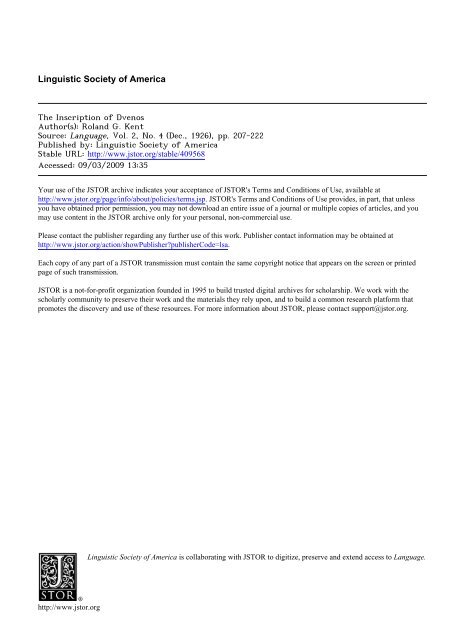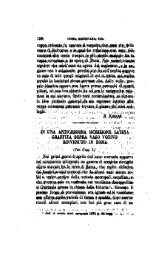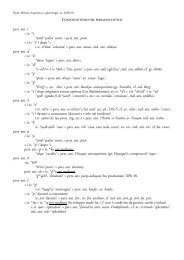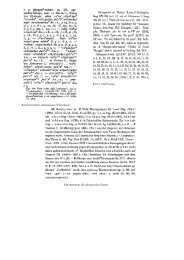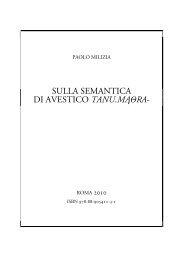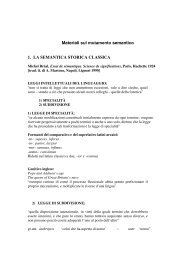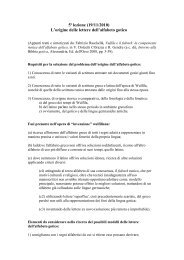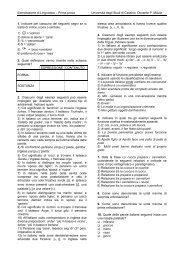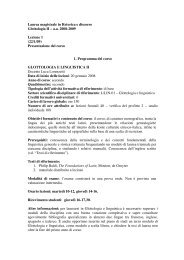Linguistic Society of America
Linguistic Society of America
Linguistic Society of America
You also want an ePaper? Increase the reach of your titles
YUMPU automatically turns print PDFs into web optimized ePapers that Google loves.
<strong>Linguistic</strong> <strong>Society</strong> <strong>of</strong> <strong>America</strong><br />
The Inscription <strong>of</strong> Dvenos<br />
Author(s): Roland G. Kent<br />
Source: Language, Vol. 2, No. 4 (Dec., 1926), pp. 207-222<br />
Published by: <strong>Linguistic</strong> <strong>Society</strong> <strong>of</strong> <strong>America</strong><br />
Stable URL: http://www.jstor.org/stable/409568<br />
Accessed: 09/03/2009 13:35<br />
Your use <strong>of</strong> the JSTOR archive indicates your acceptance <strong>of</strong> JSTOR's Terms and Conditions <strong>of</strong> Use, available at<br />
http://www.jstor.org/page/info/about/policies/terms.jsp. JSTOR's Terms and Conditions <strong>of</strong> Use provides, in part, that unless<br />
you have obtained prior permission, you may not download an entire issue <strong>of</strong> a journal or multiple copies <strong>of</strong> articles, and you<br />
may use content in the JSTOR archive only for your personal, non-commercial use.<br />
Please contact the publisher regarding any further use <strong>of</strong> this work. Publisher contact information may be obtained at<br />
http://www.jstor.org/action/showPublisher?publisherCode=lsa.<br />
Each copy <strong>of</strong> any part <strong>of</strong> a JSTOR transmission must contain the same copyright notice that appears on the screen or printed<br />
page <strong>of</strong> such transmission.<br />
JSTOR is a not-for-pr<strong>of</strong>it organization founded in 1995 to build trusted digital archives for scholarship. We work with the<br />
scholarly community to preserve their work and the materials they rely upon, and to build a common research platform that<br />
promotes the discovery and use <strong>of</strong> these resources. For more information about JSTOR, please contact support@jstor.org.<br />
http://www.jstor.org<br />
<strong>Linguistic</strong> <strong>Society</strong> <strong>of</strong> <strong>America</strong> is collaborating with JSTOR to digitize, preserve and extend access to Language.
THE INSCRIPTION OF DVENOS<br />
ROLAND G. KENT<br />
UNIVERSITY OF PENNSYLVANIA<br />
The archaic Latin inscription known as the Inscription <strong>of</strong> Duenos,<br />
from a word occurring in it which may be a personal name, stands on a<br />
small triple jar found in Rome in 1880 and first published by its finder,<br />
H. Dressel,l apparently in collaboration with F. Biicheler, who also<br />
wrote on it.2 Scholars have been busying themselves with it ever since,<br />
until we find the forty-first interpretation in a recent monograph <strong>of</strong><br />
E. Goldmann <strong>of</strong> Vienna.3<br />
l Annali dell'Instituto di corrispondenza archeologica 52.158-95 [1880].<br />
2 Rheinishes Museum 36.235-44 [1881].<br />
8 Die Duenos-Inschrift (Indogermanisches Bibliothek III.8), Winter, Heidelberg, 1926.<br />
Rich as this volume is in bibliographical references, I fail to find the following items, which<br />
might be listed for completeness:<br />
1881: H. Jordan, Bull. dell'Inst. di corr. arch. (Roma) per 1881, 84-5; F. Gamurrini, ib.<br />
85-6; P. K. in T., Correspondenzblatt f. d. Gelehrten- u. Realschulen Wiurttembergs 28.<br />
104-09.<br />
1882: C. G. Cobet, Mnemosyne, new series, 10.239; L. Havet, Revue Critique, n.s.,<br />
13.211-12, 220; K. Sittl, d. lok. Verschiedenheiten d. lat. Spr. 34-5, Erlangen; E. G. Sihler,<br />
Amer. Journal <strong>of</strong> Philol. 3.107; B. L. Gildersleeve, ib. 107 n.; C. D. Morris, ib. 146.<br />
1883: M. Breal, Comptes rendus d. seances de l'Ac. d Insc. et Belles-Lettres, 4th series, 10.<br />
23-5; W. Deecke, Bursians Jahresber. 28.233-6; H. Jordan, Deutsche Literaturzeitung,<br />
8.11; H. Jordan, Observationes Romanae subsicivae, 8-9, Konigsberg; C. D. Morris,AJP<br />
4.116-17; J. R. Wheeler, ib. 354, 360; 0. Keller, d. saturn. Vers, 40-2, Leipzig-Prag; F.<br />
Ramorino, Riv. difilol. 11.512-18.<br />
1884: W. Deecke, Burs. Jahresb. 32.365-6, 369-71.<br />
1886: L. Ceci, Giorn. ital. di fil. e ling. clas. 1.48-9; I. Zwetaieff. Insc. Italiae inferioris<br />
dialectae, 80-3, Moscow-Leipzig; E. Schneider, Dialectorum Italicarum aevi vetustioris<br />
exempla selecta 1.1.2-3, Leipzig.<br />
1887: W. Deecke, Burs. Jahresb. 44. 239-40.<br />
1889: R. S. Conway, Proc. Cambridge Phil. Soc. May 23, 1889.<br />
1890: C. Zander, Versus italici antiqui, 50-1, Lund.<br />
1896: J. C. Egbert, Intr. to Study <strong>of</strong> Latin Insc. 346-7, New York.<br />
1897: R. von Planta, Gramm. d. osk.-umb. Dialekte, 2.587, Strassburg; W. Deecke, Burs.<br />
Jahresb. 87. 21-2.<br />
1906: J. C. Egbert, Supplement to Intr. to Study <strong>of</strong> Lat. Insc., 494.<br />
1912: H. Ehrlich, Untersuchungen u. d. Natur d. griech. Betonung, 72, Berlin.<br />
1913: J. E. Sandys, Companion to Latin Studies, 733-4, Cambridge.<br />
1915: W. M. Lindsay, Short Hist. Lat. Gr.2, 199, Oxford.<br />
1916: A. Emout, Recueil de Textes Latins Archa*ques, 7-9, Paris.<br />
1921: F. Hartmann, Glotta, 11. 113.<br />
207
208<br />
ROLAND G. KENT<br />
The original editors took the inscription to pertain to the Novendial<br />
<strong>of</strong>fering, and in this they have been followed by the greatest number <strong>of</strong><br />
subsequent scholars. C. Pauli,4 in 1883, took it to be a love-charm,<br />
and this interpretation was placed on a firmer basis by R. Thurneysen5<br />
in 1899 and others, mostly German scholars. R. S. Conway, in 1889,<br />
interpreted the inscription as an execration.6 There are a few other<br />
versions which do. not fall into these classes, and some which take the<br />
inscription as a falsification <strong>of</strong> later ancient times, or <strong>of</strong> modern times.<br />
All these interpretations are listed in Goldmann's monograph.7 In<br />
examining them, one wonders whether philological imagination has not<br />
outstripped philological judgment and common sense; and whether if<br />
self-scrutiny had been more potent the scholars might not have been<br />
more restrained. Certainly many a view has been expressed that is<br />
inherently unlikely, and many another that is impossible philologically<br />
(such as DEIVOS as nominative or dative plural, andCOSMIS = cmes).<br />
Even the best <strong>of</strong> the recent etymologists disagree on critical points,<br />
such as the form and meaning <strong>of</strong> NOISI, <strong>of</strong> PARARI, <strong>of</strong> VOIS.8<br />
Yet after all may we not examine the vase and its inscription, and get<br />
some evidence which will appeal to most scholars as really valid? May<br />
we not come to some interpretation <strong>of</strong> the text which will, in its es-<br />
sentials, be satisfying to those who are not led away by their personal<br />
intellectual fancies and strivings after originality? I think that we can;<br />
and even if there is little that is new and nothing that is startling in<br />
what I have to say, therein even may lie whatever merit it possesses.<br />
The jar or vase in question is compounded <strong>of</strong> three jars, forming a<br />
small triangle, about six inches on the side. The cavities, about 35<br />
mm. deep and 45 mm. in diameter, are independent, not communicat-<br />
ing with one another. The inscription runs around the outside <strong>of</strong> the<br />
whole vase, in three lines, separated from one another by gaps, but<br />
overlapping at the ends, as the three lines go around nearly twice.<br />
When the vase is standing on its base, the letters are upside down and<br />
the inscription runs from left to right; but it is very clear that the vase<br />
should be inverted, and the letters, then right side up, should be read<br />
* Altitalische Studien 1. 1-57; Hannover.<br />
5 Kuhn's Zeitschriftf. vergl. Sprachforschung 35. 193-212.<br />
6 Amer. Journal <strong>of</strong> Philology 10. 445-59; cf. also Proc. Cambridge Philol. Soc. May 23,<br />
1889, and Academy 35. 400.<br />
7 Pp. 1-18.<br />
8 Cf. W. M. Lindsay, Short Hist. Latin Gram.2 199; F. Sommer, Handbuch der lat.<br />
Laut- und Formenlehre 2-3 413, 533, 594 f.; F. Stolz, Lat. Gram., Laut- und Formenlehre'<br />
79, 124, 157; A. Walde, Lat. etym. Worterbuch2 s.vv. nisi, vis, invitus.
THE INSCRIPTION OF DVENOS<br />
from right to left, while the first line stands below the second, and the<br />
second below the third. The order <strong>of</strong> the lines is not in doubt, as the end<br />
<strong>of</strong> the second line is bent out <strong>of</strong> direction to avoid collision with the<br />
beginning <strong>of</strong> the first line, and the end <strong>of</strong> the third line is bent away to<br />
avoid the beginning <strong>of</strong> the second line.<br />
The text <strong>of</strong> the three lines is as follows, with letters that are in any<br />
way doubtful represented by italics:<br />
(1) IOVEISATDEIVOSQOIMEDMITATNEITEDENDO-<br />
COSMISVIRCOSIED<br />
(2) ASTEDNOISIOPETOITESIAIPAKARIVOIS<br />
(3) DVENOSMEDFEKEDENMANOMEINOMDVENOINEMED-<br />
MALOSTATOD<br />
Yet even among these 'doubtful' letters, very little is doubtful. In<br />
the first line, the I was inserted after the first writing, as is shown by the<br />
crowding; some have thought that it was a word-divider or an acci-<br />
dental scratch. The A was first written E, and then corrected to A.<br />
In the second line, the K may have been corrected to C, and the same is<br />
true <strong>of</strong> the K in the third line; but this is <strong>of</strong> no significance for the in-<br />
terpretation, and will be disregarded. The V <strong>of</strong> line two is slightly<br />
irregular in shape, and it is barely possible that L should be read. In<br />
the third line, the E was first written D, by haplographic loss <strong>of</strong> EINOM,<br />
but was corrected before further false copying was done. The I runs far<br />
below the line, intersecting the horizontals <strong>of</strong> E in ENDO, line one;<br />
for this reason, von Grienberger9 thinks it an accidental mark; but the<br />
spacing distinctly demands the presence <strong>of</strong> a letter between E and N.<br />
The V was at first omitted, and when inserted was so restricted for<br />
space that it consists only <strong>of</strong> a vertical with a short cross-stroke at the<br />
bottom; it was first read Z or I, but M. Breal'0 soon recognized its true<br />
value. The L, as Breal was again first to note,1' seems to have been<br />
written at first with the angle at the top, then corrected by the partial<br />
erasure <strong>of</strong> the oblique stroke and the addition <strong>of</strong> the side stroke at the<br />
bottom; some earlier editors took it for an N, or for an A written by<br />
error for N.<br />
The text is therefore certain within very narrow limits; for little real<br />
doubt remains about the value <strong>of</strong> the characters just discussed. Some<br />
9 Indogermanische Forschungen 11. 342-3.<br />
10 Melanges d'arch. et d'hist. (Ecole fr. de Rome) 2. 147-67, esp. 148-9, = Revue Arche-<br />
ologique, new series, 44. 82-98, esp. 83-4 [1882].<br />
11 Melanges 2. 162= Rev. Arch. 44. 94.<br />
209
210<br />
ROLAND G. KENT<br />
editors have seen 'errors' in one or more <strong>of</strong> twelve characters. Even<br />
these variationsl2 do not lead to very divergent texts; but diverse word<br />
divisions produce the great differences. Actually, the only words con-<br />
stant in form and in interpretation in all versions, are MED FEKED in<br />
the third line.<br />
Of course if we but knew with some degree <strong>of</strong> certainty the purpose for<br />
which the vase was designed, we might interpret the inscription with<br />
some assurance. Still, there is a limited amount <strong>of</strong> internal evidence:<br />
the triple nature <strong>of</strong> the vase, the fact that it must be turned upside<br />
down to read the inscription, the retrograde character <strong>of</strong> the writing,<br />
all point to association with some form <strong>of</strong> magic, baleful or otherwise, or<br />
to an execration. These arguments have been elaborated at great length<br />
by Goldmann,'3 who regards the three cavities as destined for the<br />
burning <strong>of</strong> smoke-producing substances, in the magic rites for which the<br />
vase was intended. But all his arguments serve equally well, if we take<br />
the inscription to be an execration.<br />
Now a very acute remark <strong>of</strong> Th. Bergk14 has passed almost unnoticed,<br />
that as the inscription is upside down when the vase is in a normal posi-<br />
tion with the openings upward, the recipient way read it properly only<br />
when the vase is placed upside down. The inference is that the vase was<br />
intended to be placed somewhere with the openings downward. Three<br />
has, as everyone knows, always been a number <strong>of</strong> magic potencies; and<br />
when Deecke'5 divided the opening letters <strong>of</strong> the inscription 10 VEI SAT,<br />
as abbreviations <strong>of</strong> the names <strong>of</strong> the gods Jupiter, Vejove, and Saturn, a<br />
triad worshiped on the Capitol, and the last two <strong>of</strong> them associated with<br />
the netherworld, it becomes quite convincing. We get a likely presump-<br />
tion that the vase was to be buried with the mouths downward, ad-<br />
dressed to the three deities, one <strong>of</strong> whom was to have a dwelling in<br />
each cavity, while operating the appeal on the vase, which in this<br />
position was legible to them. It is true that the first line is now physi-<br />
cally the lowest, and the third line is physically the highest; but the<br />
chthonic deities, rising to inspect the gift, would perceive and read the<br />
lowest line first. We thus arrive at the view that Conway was the first<br />
12 Only C. Moratti (Giorn. ital. di fil. e ling. clas. 1. 100-2 [1886]; also La iscrizione<br />
arcaica del Foro Romano e altre, Bologna, 1900-this latter not accessible to me)has done<br />
great violence to the text; he sees omissions and ligatures almost everywhere.<br />
13 Pp. 19-51.<br />
14 Kleine philolog. Schriften=Opuscula philologica Bergkiana 1. 646 [18841.<br />
"1 Altitalische Vermuthungen 180, in I. Zwetaieff, Insc. Ital. inf. dial. [1886]; Bursians<br />
Jahresbericht 44. 239 [1887].
THE INSCRIPTION OF DVENOS<br />
to propound, that the inscription is an execration. The argument just<br />
presented is my reason for rejecting the theory that it is a love-charm,<br />
to which will be added the arguments from the interpretation later<br />
given; on the other hand, all association with the Novendial sacrifice<br />
disappears when DVENOI NE is read in the third line, instead <strong>of</strong> DZE<br />
NOINE = die noni.<br />
One more point before we proceed to the interpetation <strong>of</strong> the text:<br />
the fact that the three lines are separated by gaps capable <strong>of</strong> holding<br />
several letters, gives a strong presumption that each line is reasonably<br />
complete in itself; and this completeness may be expected to apply both<br />
to sense and to syntax. The point is worth emphasizing, although most<br />
editors have recognized it by implication, and Goldmann has applied it<br />
rigidly.<br />
To take up now the text <strong>of</strong> the inscription, the first line reads as<br />
follows, with the word divisions which I adopt:<br />
IO VEI SAT DEIVOS QOI MED MITAT NEI TED ENDO<br />
COSMIS VIRCO SIED<br />
After the abreviated names <strong>of</strong> the three gods, first recognized by<br />
Deecke (as was mentioned above), there is a word which means 'god'<br />
or 'gods', in some case or other, Morphologically, unless we are to<br />
accept a form without parallel in Latin, it must be either nominative<br />
singular or accusative plural; and the latter is required by the names <strong>of</strong><br />
the three gods, to which it is an obvious appositive. The abbreviations<br />
therefore represent the accusative case.<br />
QOI MED MITAT can hardly mean other than 'he who sends me'.<br />
It is true that Q = qu is not otherwise known, but no conceivable variant<br />
interpretation eliminates this peculiarity. MITAT <strong>of</strong>fers difficulties,<br />
since it seems to be subjunctive in form,=mittat; but the final letter <strong>of</strong><br />
the subjunctive should at this early date be d, the secondary ending,<br />
and not t, which is primary; cf. SIED and FEKED in the inscription,<br />
and the Oscan present subjunctives fakiiad, kahad, putiiad, where the<br />
secondary d is obvious. The T has been explained as showing the be-<br />
ginning <strong>of</strong> the extension <strong>of</strong> primary -t into the realm <strong>of</strong> the secondary<br />
endings,'6 or as a plural with graphic omission <strong>of</strong> the n before the stop;17<br />
but why should the clause have a subjunctive at all?<br />
16 Bucheler, RhM 36. 243; and especially G. Hempl, Trans. Amer. Philol. Assn. 33.<br />
153-4 [1902].<br />
17 R. S. Conway, AJP 10. 452.<br />
211
212<br />
ROLAND G. KENT<br />
I must anticipate a trifle at this point. I take the first part <strong>of</strong> the line<br />
as meaning 'He who sends me, (prays) the gods Jupiter, Vejove, (and)<br />
Saturn, that ....', with ellipsis <strong>of</strong> some verb <strong>of</strong> entreaty.18 Conway and<br />
Hempl supply a verb <strong>of</strong> giving,19 in the subjunctive, with the gods as<br />
subject. But here I must take notice <strong>of</strong> the alternative interpretation<br />
IOVESAT=iurat, with disregard <strong>of</strong> the I, which, as has been said, is<br />
clearly a later insertion. This view, foreshadowed by Thurneysen,20<br />
was definitely put forth by von Grienberger,2' and has had a very<br />
distinguished following. And yet iurat deos ought not to mean anything<br />
other than 'swears by the gods', while the meaning demanded is 'prays<br />
to, implores, beseeches the gods', which is properly represented by<br />
adiurat.22 I am tempted to admit that the first letters <strong>of</strong> the line are to<br />
be read twice, once without and once with the inserted I, as follows:<br />
IOVESAT 10 VEI SAT DEIVOS<br />
'he implores the gods Jove, Vejove, (and) Saturn....'; for a similar<br />
double reading in each <strong>of</strong> the other lines is easily found, and helps the<br />
meaning. In this case, we should have to accept iurat=adiurat, the<br />
simple verb for the compound, as in poetry: a violence which is not too<br />
drastic for a formula <strong>of</strong> execration.<br />
Now why should MITAT be a subjunctive? The only excuse would be<br />
that the relative clause is <strong>of</strong> a general nature, as in Greek 8s &v ii4s7r^;2*<br />
but this implies that the vase is a stock article, not one made and lettered<br />
for a special occasion: a view inherently improbable, both from the<br />
peculiarity <strong>of</strong> the inscription and from the peculiarity <strong>of</strong> the form <strong>of</strong> the<br />
vase. The same objections, both as to meaning and as to the final T,<br />
are valid against Bucheler's view24 that MITAT is a future indicative.<br />
I cannot convince myself that the clause is general, and believe that in<br />
MITAT we must seek a present indicative.<br />
There is another difficulty with MITAT = subjunctive mittat. Single<br />
T would <strong>of</strong> course at the time <strong>of</strong> this inscription have been written for a<br />
doubled T; but should we not expect MEIT- at this early date? For this<br />
18 As indeed Miss F. M. Bennett, Proc. Am. Philol. Assn. 41.xxii [1910], takes it.<br />
19 Cf. the parallels cited by Conway, AJP 10. 454, and the prayers quoted in Cato,<br />
Agr. 141 end.<br />
20 KZ 35. 196 l1899].<br />
21 IF 11. 342-3 [1900].<br />
22 M. Jeanneret, La langue des lablettes d'ex&cration latines 106-7, Paris-Neuchftel, 1918.<br />
? Bucheler, RhM 36. 243 [18811.<br />
u Biicheler, Ic.
THE INSCRIPTION OF DVENOS<br />
vase precedes the monophthongizing <strong>of</strong> the diphthong, and there is no<br />
other likely etymology for mitto than that which derives it from *mito,<br />
and this from a still earlier *meito, presumably from *smeito. The early<br />
subjunctive would then be *MEITAD, not MITAT. Even the concession<br />
<strong>of</strong> an entering variation in the ending does not free us from the problem<br />
<strong>of</strong> the diphthong.<br />
But it is possible that there were two present formations from this<br />
root.25 We find d1cere indicere and dicare indfcdre, ducere educere and<br />
educdre; there may have been a *mXtdre alongside *meitere *mtere<br />
mittere. This *mtdre yields a present indicative mltat, properly represented<br />
in our text; there is no difficulty about the final T, nor about<br />
the radical I, nor about the syntax <strong>of</strong> the mood.26<br />
The remainder <strong>of</strong> this line <strong>of</strong> the inscription was quite properly divided<br />
by the first editors, and was interpreted by them ne te intus comes virgo<br />
sit, wherein te is object <strong>of</strong> the phrase comis sit=comitetur: 'let not a<br />
maid accompany thee within (to the ceremonies)'. Osth<strong>of</strong>f 27 and Jordan28<br />
recognized that COSMIS could not be the old form <strong>of</strong> comes, but<br />
was the old form <strong>of</strong> comis, and Jordan29 and Breal30 independently took<br />
TED ENDO as in te. The VIRCO, with all the earlier editors, was a<br />
human maiden; Conway31 first noted that this whole clause is a translation<br />
<strong>of</strong> the Greek g7 eiXaroa6s ?oL d Kop71, which may reasonably be<br />
inferred from its converse /'1 TVrXOL Ac/Iarpos Kal [K]6pas JLsjC Oe.v irap&<br />
A6Ltiarpos eviXarcow and other like phrases in the Cnidian curses.32 VIRCO<br />
therefore means Proserpina, as goddess <strong>of</strong> Hades; and though this<br />
interpretation has been accepted only by Lindsay,33 Hempl,34 Miss<br />
25 Cf. P. G. Goidanich, Riv. di storia antica, n.s., 5. 233 [1900].<br />
26 Perhaps such a formation lurks in the deponent imftdri, which may be for *in-mltari,<br />
even as *ob-mittere has become omittere; for the meaning, *in-mitdri may well mean 'to let<br />
one's self go into (something), to identify one's self with, to imitate', cf. Plaut. Cas. 443<br />
recessim dabo me ad parietem, imitabor nepam 'I'll draw <strong>of</strong>f backwards to the wall, I'll<br />
imitate a crab'. Of course, such an etymology <strong>of</strong> imitdrl separates it from aemulus and<br />
imago.<br />
27 RhM 36. 482-4 [1881].<br />
28 Hermes 16. 233-8 [1881].<br />
29 Hermes 16. 235.<br />
213<br />
30 Mel. 2. 155 =Rev. Arch. 44. 89 [1882].<br />
31 AJP 10. 453 [1889].<br />
32 A. Audollent, Defixionum Tabellae, pp. 5-19, esp. No. 4; Paris, 1904.<br />
33 Short Historical Latin Grammar, ed. 1, 175, Oxford [1897], ed. 2, p. 199 [1915];<br />
Handbook <strong>of</strong> Latin Inscriptions 19-23, Boston, 1897.<br />
34 TAPA 33. 150-69 [1902].
214<br />
ROLAND G. KENT<br />
Bennett,35 and provisionally by Audollent,36 it is absolutely harmonious<br />
with the other evidence which we have so far gathered. As for NEI<br />
in the meaning <strong>of</strong> ne, its use is adequately attested by examples both<br />
literary and inscriptional.37<br />
With the first line thus disposed <strong>of</strong>, it would be natural to take up next<br />
the second line; but its difficulties are to a certain extent mitigated by a<br />
previous interpretation <strong>of</strong> the third line, which, while not unduly<br />
transparent, is yet susceptible to a fair treatment. The text is:<br />
DVENOS MED FEKED EN MANO MEINOM DVENOI<br />
NE MED MALO STATOD<br />
The uncertainties about the italicized letters have already been<br />
mentioned; those about the K and the E in no way affect the meaning,<br />
while the I is demanded by the spacing, and is therefore not an ac-<br />
cidental scratch. Breal's DVENOI NE and MALO are virtually certain<br />
and have been adopted in nearly all recent versions.<br />
The second half <strong>of</strong> the line was clarified by Conway with the aid <strong>of</strong><br />
further parallels from the Cnidian curses;38 he took the MALO as a<br />
nominative neuter with omitted final m, and translated 'To Duenos let<br />
not evil arise through or on account <strong>of</strong> me'. This is, as he shows, a<br />
regular formula to prevent the curse from reacting upon its maker, and<br />
here follows close after the phrase DVENOS MED FEKED 'Duenos<br />
made me'.<br />
There remains only ENMANOMEINOM, which has been explained<br />
in the most diverse ways. Now there is a curious feature <strong>of</strong> the interpre-<br />
tations: only Lindsay39 has noted that here only, at the end <strong>of</strong> this<br />
phrase, is M written before a consonant. The possible instances <strong>of</strong> final<br />
m are none too numerous, it is true; but we have MALO"' toward the<br />
end <strong>of</strong> this line, MANOm if we divide MANO MEINOM (though the<br />
M <strong>of</strong> MEINOM may be doing double duty), and the dubious interpreta-<br />
tions OPEm and PAKARIm in the second line. At all events, the natural<br />
inference is that after MEINOM there is a pause marking the end<br />
<strong>of</strong> the clause, as Lindsay takes it; in addition to Lindsay, only Com-<br />
" PAPA 41.xxi-xxiv [1910].<br />
M Op. cit. 193-4 [1904].<br />
37 Cited in C. E. Bennett, Syntax <strong>of</strong> Early Latin 1. 169, 219, 234, 254, 265, 269; perhaps<br />
the examples <strong>of</strong> pp. 182-4 also are relevant.<br />
'8 AJP 10. 455-6.<br />
"9 Handbook <strong>of</strong> Latin Insc. 22.
THE INSCRIPTION OF DVENOS<br />
paretti,40 E. W. Fay,41 and now Goldmann,42 make the division at<br />
this point. In my opinion, there is only one interpretation <strong>of</strong> this phrase<br />
which is at all satisfactory, that <strong>of</strong> Ehrlich:43 MANO is a genitive plural,<br />
a euphemistic term for ghosts <strong>of</strong> the dead, for the archaic adjective<br />
madnus= bonus is adequately attested, and appears with another suffix<br />
in Manes Mdnium; and MEINOM is equivalent in meaning to munus<br />
(older *moinos), but has a different ablaut grade in the root and a<br />
slightly different suffix. Thus he interprets in Manium munLus 'as a<br />
gift to the Manes'. I should alter this to 'as a gift to the Deities <strong>of</strong><br />
Hell', understanding these deities as the three gods <strong>of</strong> the first line.<br />
Accordingly 'Duenos made me as a gift to the Deities <strong>of</strong> Hell; to<br />
Duenos let no evil arise through me.' But who or what is Duenos?<br />
The word may be a personal name, for there was a praenomen Bennus<br />
and a gentilicium Duennius or Bennius;44yet this was in any instance a<br />
rare name. On the other hand, DVENOS may be a mere descriptive<br />
adjective, = bonus, <strong>of</strong> which, if the nasal be not for the doubled nasal, it<br />
is certainly an older collateral form. In view <strong>of</strong> the rarity <strong>of</strong> the name<br />
Bennus and <strong>of</strong> the possibility that the execrator might desire to disguise<br />
his identity, I incline to the view that DVENOS is bonus 'a good man',<br />
uttered in earnest and not as a euphemism. It is likely that the loss <strong>of</strong><br />
mdnus 'good' in the language was due to its extensive use as a euphemism,<br />
especially in the derivative Manes, so that it lost its original meaning<br />
and its place was usurped by bonus. At the same time, there is a distinct<br />
possibility that in this third line, as well as in the first line, the initial<br />
word was written with a double value, DVENOS DVENOS 'Bennus, a<br />
good man'; though I do not insist that the actual name was Bennus, but<br />
was near enough in sound to DVENOS to give some appropriateness to<br />
the graphic representation. Whether or not this be so, the word denotes<br />
the execrator, either (as we shall later see) a private individual cursing a<br />
personal enemy, or a priest cursing a person who in some way has sinned<br />
against the deity served by the priest. It seems unlikely that F. D.<br />
Allen45 is right in taking it to refer to a pr<strong>of</strong>essional sorcerer who cast the<br />
spell; even less likely is it that it denotes the potter who made the vase,<br />
40 Museo ital. di antichitd classica 1. 175 ff. [1885].<br />
41 AJP 30. 121-38 [1909].<br />
42 Op. cit. 120.<br />
43 Untersuchungen iuber die Natur der griechischen Betonung 72, Berlin, 1912.<br />
u Cf. H. Jordan, Hermes 16. 237-8 [1881]; W. Deecke, RvhM 37. 385-6 [1882]; W.<br />
Schuize, Zur Geschichte lateinischer Eigennamen 423, 519, Berlin, 1904; A. Zimmermann,<br />
Philologus 72. 158 [1913].<br />
4 Harvard Studies in Classical Philology 9. 53-4 [18981.<br />
215
216<br />
ROLAND G. KENT<br />
unless he be identical with the actual execrator. For neither the sorcerer<br />
nor the potter would stand in danger <strong>of</strong> the reaction <strong>of</strong> the curse, cer-<br />
tainly not as compared with the actual execrator.<br />
There remains the puzzling second line, which we may divide with the<br />
original editors, provisionally:<br />
ASTED NOISI OPE TOITESIAI PAKARI VOIS<br />
Since Allen46 in 1898, only Goidanich47 and Lindsay48 have dared<br />
divide the words in this fashion, for Thurneysen49 in 1899 set a different<br />
style, with OP ET OITES IAI, which has served as a basis for other<br />
variations. Yet when we come to interpret, we may be guided to a<br />
certain extent by the implications derived from the other two lines.<br />
The first line contains an appeal to a triad <strong>of</strong> gods, and an imprecation<br />
upon someone; the third line has the maker's admission <strong>of</strong> responsibility<br />
and a prayer that the curse turn not back upon the maker. What is<br />
lacking in the usual curse formula? The lacking part is, as Conway ob-<br />
served, a proviso under which the execrated person might avoid the<br />
penalty by some manner <strong>of</strong> reparation. This is what should be found<br />
in the second line.<br />
If NOISI be not somehow equal to nisi and VOIS be not somehow<br />
equal to the verb vs, it is difficult to reach such a meaning. Most editors<br />
do indeed so interpret them; but a long and distinguished line <strong>of</strong> editors,<br />
starting with Breal and closing with the latest investigator, Goldmann,<br />
take NOISI (or NOIS) as dative nobis, and VOIS as vobis. The chief<br />
difficulty with this view, in addition to the lack <strong>of</strong> harmony with the rest<br />
<strong>of</strong> the inscription, is that <strong>of</strong> finding the dramatis personae for a plural<br />
'we' and a plural 'you'; and on the other hand the diphthong -oi- in<br />
earlier forms <strong>of</strong> nisi and vis needs explanation.<br />
Latin nisi is from *nei-seif,5 with regular development <strong>of</strong> the sounds,<br />
which involves the shortening <strong>of</strong> long close e from accented ei, because <strong>of</strong><br />
the enclitic attached. Final original ei became monophthongal i at an<br />
early date;51 a form *nesi developed, which might be written with final<br />
ei by the influence <strong>of</strong> orthotone sei, later si; through use <strong>of</strong> the whole<br />
word as unaccented, or by vowel assimilation, *nesi became nisi<br />
48 L. c.<br />
47 L. c., in note 25.<br />
48 Short Hist. Latin Gram,2 199 [1915].<br />
49 KZ 35. 198.<br />
60 Walde. Lat. etym. Wortb.h 520. s.v. nisi.<br />
511 hold with Ehrlich, Unters. 72-9.
THE INSCRIPTION OF DVENOS<br />
iambic shortening shortened the final vowel. Now where in this line<br />
<strong>of</strong> descent is there a place for NOISI? Some52 have thought that at the<br />
time <strong>of</strong> the inscription the unaccented oi, as in the dative-ablative and<br />
the nominative plural <strong>of</strong> o-stems, was just changing in sound to ei, and<br />
that this was productive <strong>of</strong> confusion in spelling in any position in the<br />
word; thus NOISI might be graphic for *neisi. Others53 have compared<br />
with NOISI the Umbrian nosue, apparently for *noi-svai, with different<br />
ablaut grade <strong>of</strong> the negative particle. Still others54 have seen, both in<br />
NOISI and in nosue, the negative *noin, later non (from *ne oinom) as<br />
first element, the nasal being omitted in writing. I myself justify the<br />
oi <strong>of</strong> NOISI as due to an uncertainty in the pronunciation <strong>of</strong> the diphthong,<br />
combined with an influence from the negative *noin.<br />
As for VOIS, some explain the oi as due to the uncertain value <strong>of</strong> the<br />
ei and oi, as in NOISI. Others55 have equated VOIS directly with Sanskrit<br />
vesi 'thou wishest', taking Sanskrit e for original oi; but in an<br />
athematic monosyllabic formation, this ablaut-grade is extremely<br />
improbable. I accept a theory which in its essentials started with the<br />
first editors:56 *welo *welsi *welti became volo *vols zvolt with o before the<br />
velar I; *vols resisted the change -Is to -I even as -rs did not become -r<br />
infers, by the analogy <strong>of</strong> other second persons singular; *vols, having a<br />
consonant group abnormal in the language, became *vois (our VOIS),<br />
which later became *veis vis, even as *woinom (cf. Greek fotVoS) became<br />
*veinom vinum. Thus our VOIS represent the normal pronunciation at a<br />
certain stage in the development.57<br />
The ASTED which begins the line may next be considered. The first<br />
editors took it to be a verb, adstet, with the negative carried over from<br />
the first line: '(and) may she not stand by (thee)'; many editors adopt<br />
this. Jordan58 saw in it a lengthened form <strong>of</strong> ast, cf. post and postid.<br />
62 Notably Hempl. TAPA 33. 155-7.<br />
" Beginning with Dressel, Ann. dell'Inst. 52. 180 [1880], and Bucheler, Rh7M 36.<br />
238 [1881].<br />
" Cf. the remarks <strong>of</strong> F. D'Ovidio, Rivista difilologia 10. 118-19 [1882].<br />
" So H. Osth<strong>of</strong>f, RhM 36. 486 [1881].<br />
u Dressel, l.c.; Bucheler, RhM 36. 239; Breal, Mel. 2. 157 =Rev. Arch. 44. 90 [1882];<br />
etc. It makes no difference in this interpretation whether the forms were thematic or non-<br />
thematic. If thematic, then the thematic vowel was lost by syncope; and the change <strong>of</strong><br />
the vowel from e to o, if preceding the syncope, was analogical to that in the first person,<br />
as in colo colis colit, where the original radical vowel was e.<br />
67 In this way the present tense <strong>of</strong> volo can be derived without having recourse to<br />
elements from any other root; yet vis may represent a contamination with equivalent <strong>of</strong><br />
Skt. vksi or with the root in invitus. Cf. Walde. Lat. etym. Wrtb.2 s. vv.<br />
6Hermes 16. 235-6 [1881].<br />
217
218<br />
ROLAND G. RKENT<br />
Breal59 took it to be ASt TED, with T doing double duty, and in this is<br />
followed by a number <strong>of</strong> eminent scholars. Allen60 interpreted it as<br />
abs te, but admits the possibility <strong>of</strong> abstet. To me the correct interpretation<br />
seems to lie somewhere in the possibilities suggested by Breal and<br />
by Alien.<br />
If we turn now to the remaining words, OPE TOITESIAI PAKARI,<br />
we find that almost every imaginable division has been tried for the<br />
purpose <strong>of</strong> securing an interpretable text; yet I think that after all we<br />
cannot better the text <strong>of</strong> the first editors, the form in which I have<br />
quoted the words. OPE may be dative (*opai>*opei>*ope, with long<br />
close e, before becoming opl), as the first editors took it; or accusative,<br />
with graphic omission <strong>of</strong> the final m, as apparently Bergk6' took it; or<br />
ablative,as Deecke62 first took it. TOITESIAI may be dative,in apposition<br />
with a dative OPE, or separate from it; or it may be genitive, depending<br />
on OPE in whatever case that word may be. Of a number <strong>of</strong><br />
views on PAKARI, there are but two which deserve consideration; that<br />
it is the present passive infinitive, as the first editors thought, and that it<br />
is an accusative adjective with an omitted final m, as Lindsay63 has<br />
maintained. The chief interpretations <strong>of</strong> the phrase, with their first<br />
advocates, are 'unless thou wished to make sacrifice (to be reconciled)<br />
to Ops Tuteria' (Dressel), '(wishest the Ops <strong>of</strong> Tuteria to be appeased'<br />
)Bergk), 'wishest to secure the help <strong>of</strong> Tuteria' (Allen), 'wishest to besome<br />
reconciled by the help <strong>of</strong> Tuteria' (Deecke), 'wishest the help <strong>of</strong><br />
Tuteria (to be) favorable' (Lindsay).<br />
But Lindsay's view that PAKARI =*pacrim,64 with anaptyxis, is<br />
hardly tenable. His refusal to accept the infinitive is motivated by two<br />
desires, to avoid acceptance <strong>of</strong> rhotacism and keep lOVESAT= iurat<br />
and TOITESIAI =*Tuteriae, and to retain freedom to explain the passive<br />
infinitive as a dative in -ai, which would not have become monophthongized<br />
at the time <strong>of</strong> this inscription. But neither desire is justified.<br />
If IOVESAT is to be taken as representing iurat, it is only as a second<br />
reading <strong>of</strong> the opening words; for it disregards the hasta inserted after<br />
the E by the original scribe. If I have tentatively admitted it, it is<br />
59 Mel. d'Arch. 2. 157= Rev. Arch. 44. 90 [1882].<br />
60 L. c., in note 45.<br />
61 Kl. philol. Schriften 1. 644-51 [1884].<br />
62 Altital. Vermutungen 180 [1886]; cf. note 15.<br />
63 Citations in note 33.<br />
M The warrant for this word is the Umbrian pacer 'propitius', nom. sg., and pacrer,<br />
nom. pl.
THE INSCRIPTION OF DVENOS<br />
only for the intentionally enigmatical character <strong>of</strong> the text which is<br />
thereby produced. Thus an archaic form might be used with the in-<br />
tervocalic S, even though rhotacism had normally entered into such<br />
groups <strong>of</strong> sounds. TOITESIAI is a personal name or its virtual equiva-<br />
lent and might well resist rhotacism for some time longer than an ordi-<br />
nary word; or it might be a country form, cf. such doublets as Valerius<br />
and Valesius among proper names <strong>of</strong> later times. As for the passive<br />
infinitive in -i, there is no evidence that it goes back to an earlier -ei<br />
from a primitive -ai, for the first inscriptional examples showing El<br />
are <strong>of</strong> the year 117 B.C., when I and ei had long been confused; and<br />
there is nothing which if added to a final -ei would produce the -ier <strong>of</strong><br />
the alternative form <strong>of</strong> the infinitive, common in the works <strong>of</strong> Plautus,<br />
whose date makes it impossible to take it as an extension <strong>of</strong> a form in<br />
which the final diphthong had already become a monophthong.6'<br />
Thus the objections to PAKARI as an infinitive are eliminated; but<br />
there are also positive objections to PAKARI as an adjective. If it be<br />
taken as for *pacrim, there is an anaptyctic vowel; but the anaptyctic<br />
vowel <strong>of</strong> Latin was not a, but e, and if we take recourse to the dialects,<br />
that <strong>of</strong> Oscan had the same quality as the vowel which adjoined the<br />
liquid or other sound mainly responsible for the phenomenon. Thus an e<br />
or an i might develop in *pacrim, but not an a. Lindsay's alternative<br />
suggestion66 that PAKARI is from a stem *pacdri-, falls because the<br />
suffix -ari- is merely a dissimilated form <strong>of</strong> the suffix -dli- which devel-<br />
ops after another 1 in the stem. A *pacdriom with syncope is equally out<br />
<strong>of</strong> the question, since the r is here the product <strong>of</strong> rhotacism. Nothing is<br />
gained by regarding PAKARI as other than a passive infinitive.<br />
To return to ASTED, the interpretation adstet, with a carrying over <strong>of</strong><br />
the negative <strong>of</strong> the first line, is rather forcing the matter. The three<br />
lines are separated by such gaps that the separation cannot be unin-<br />
tentional; and as I have said, we may expect the lines to be reasonably<br />
independent in syntax and in meaning. After the 'may the Maid not be<br />
kind to thee' <strong>of</strong> the first line, and before the 'unless thou wilt ...'. <strong>of</strong><br />
the second line, we should look for something like 'but may she torture<br />
thee'. Three interpretations fit this view: ASt TED with an implied<br />
torqueat or the like would mean 'but (may she torture) thee'; AbS TED<br />
with an implied verb <strong>of</strong> alo<strong>of</strong>ness would mean 'from thee (may she<br />
stand alo<strong>of</strong>)'; AbSTED would mean 'may she stand away (from thee)'.<br />
I am not particularly concerned which <strong>of</strong> these three views is to be<br />
tt Cf. F. Sommer, Handb. d. lat. Laut- u. Formen1.>3 593-4.<br />
u Handbook <strong>of</strong> Latin Insc. 20.<br />
219
220<br />
ROLAND G. KENT<br />
chosen, as all give the same meaning to the inscription; but I am interested<br />
to note that the ASTED, like the intial letters <strong>of</strong> the other<br />
lines, can be read twice, and in two ways: ASt TED AbSTED 'but<br />
may she stand alQ<strong>of</strong> from thee', with an ablative <strong>of</strong> separation without a<br />
preposition, and AbS TED AbSTED 'may she stand alo<strong>of</strong> from thee',<br />
without the adversative adverb. As between the two, I prefer the former;but<br />
I do not insist on the double reading.67<br />
We come now to the significance <strong>of</strong> the formula <strong>of</strong> mitigation. Probably<br />
PAKARI has a middle meaning, 'to make peace with, to make<br />
atonement to' the <strong>of</strong>fended party. The <strong>of</strong>fended party is obviously<br />
indicated by QOI MED MITAT, and very probably also by DVENOS;<br />
both QOI and DVENOS are masculine. Both OPE and TOITESIAI<br />
are feminine. If OPE be dative and we translate 'unless thou wishest to<br />
make atonement to Ops Tuteria', or if OPE be accusative and we<br />
translate 'unless thou wishest Ops <strong>of</strong> Tuteria to be placated', we must<br />
explain why a man is reliquishing his wrath if a female be appeased. This<br />
can be made reasonable only if the man is a priest execrating a person<br />
who has in some way <strong>of</strong>fended the goddess served by the priest. The<br />
transgression may have been a misappropriation <strong>of</strong> movable property<br />
belonging to the goddess.<br />
In any case, if reparation or atonement is considered possible, the<br />
older view that the accursed person was dead, becomes absurd. The<br />
ancients, except the adherents <strong>of</strong> some beliefs not known in Rome at the<br />
time <strong>of</strong> this inscription, did not impute to the dead ghosts in shadowy<br />
hell the power and facilities for making atonement for sins committed in<br />
this mortal life. It is a living person who is the object <strong>of</strong> the curse.<br />
Ops Tuteria is an otherwise unknown combination, though Ops is well<br />
known as the wife <strong>of</strong> Saturn, and is provided with a variety <strong>of</strong> appellatives;<br />
and abstracts a-plenty are listed as divinities by Gellius,68 with<br />
descriptive epithets. Yet these supply no fair parallel to Lindsay's<br />
'Help <strong>of</strong> Tuteria', for in them the genitive is the name <strong>of</strong> a well-known<br />
divinity: Saturn, Neptune, Quirinus, Vulcan, Juno, Mars. There is<br />
nothing like Tuteria, a name not attested elsewhere; for which reason,<br />
if the OPE TOITESIAI denote a goddess, it is reasonable to take it<br />
rather as Ops Tuteria than as the Ops <strong>of</strong> Tuteria. Yet why should a<br />
67 I am aware that the verb absto is a very rare word, occurring only in Horace AP<br />
362; for when compounds <strong>of</strong> ab and ad would become identical in form, it is the compounds<br />
<strong>of</strong> ab which disappear or change their form, cf. apporto and asporth, accido and abscfd5,<br />
afer7 and aufero. I do not therefore insist that the word is to be found in this inscription.<br />
The meaning to be conveyed is however reasonably certain.<br />
" Nodes Atticae 13. 23. 2.
THE INSCRIPTION OF DVENOS<br />
priest, <strong>of</strong>ficial representaive <strong>of</strong> the goddess, have recourse to a written<br />
execration rather than to the arm <strong>of</strong> the law? Slight as this point is, it<br />
makes me wonder if we have not to do with a quarrel between two<br />
human persons merely, wherein a doubt as to the sufficiency <strong>of</strong> the<br />
evidence, or a partial culpability <strong>of</strong> the <strong>of</strong>fended party,or a distrust and<br />
dislike <strong>of</strong> litigation, restrained the complainant from recourse to the<br />
courts.<br />
If this should be so, OPE is an ablative, as Deecke first took it, and<br />
the clause means 'wishest to make atonement by the aid <strong>of</strong> Tuteria'.<br />
Then Tuteria is a living human being, who from some reason or from<br />
some peculiar circumstance, now unknown and unknowable, had the<br />
power to still the wrath <strong>of</strong> the <strong>of</strong>fended man; could she have been<br />
Vestal? Can the name, so obviously associated with ftutus 'safe'69 be<br />
not a name, but a conventional appellative for a Vestal exercising her<br />
privilege <strong>of</strong> intercession or protection Or is it used here, perhaps, for<br />
distinction <strong>of</strong> this virgo from the dangerous VIRCO <strong>of</strong> the first line ?<br />
Is there, after all, any name <strong>of</strong> a human being in the inscription?<br />
The gods are named, indeed: IO, VEI, SAT, DEIVOS, VIRCO,<br />
MANO. But the human beings are concealed under QOI, TED, DVE-<br />
NOS-'he who', 'thee', 'a good man', unless this last be a convenient<br />
disguise for the name Bennus. So if OPE TOITESIAI be not the name<br />
<strong>of</strong> a deity, the TOITESIAI is but an appellative for a woman, 'the<br />
salutary'. By such avoidance <strong>of</strong> personal names, the execration is made<br />
more difficult to counteract, and less likely to recoil upon its maker.<br />
Between these two interpretations <strong>of</strong> OPE TOITESIAI I find my-<br />
self unable to pronounce with conviction. The tw<strong>of</strong>old interpretation<br />
<strong>of</strong> the initial words <strong>of</strong> the lines likewise interests me, but does not thrill<br />
me, and I lay no weight upon it, for the interpretation <strong>of</strong> the inscription<br />
as a wholeis not affected. With these reserves, the present interpretation<br />
seems to me to come reasonably near objective demonstration. I<br />
therefore now present my text and version, which, let me emphasize, is<br />
an eclectic one, resting, save in some minor points, on the authority <strong>of</strong><br />
previous scholars:<br />
9 I am not unaware <strong>of</strong> certain etymological difficulties in equating tutus with an earlier<br />
toitos; for tatus is the participle <strong>of</strong> tueor, and the root <strong>of</strong> tueor is *teu- or a similar root with<br />
a u-diphthong. But as tuitus is a collateral form <strong>of</strong> talus, the -oi- <strong>of</strong> TOITESIAI may<br />
stand in somewhat the same relation to the -ui- <strong>of</strong> tuitus as the -oe- <strong>of</strong> oboedio stands to<br />
the -ui- which should have developed by regular weakening in *ob-awisdi.<br />
221
222<br />
ROLAND G. KRENT<br />
[IOVESAT] IO VEI SAT DEIVOS QOI MED MITAT NEI TED<br />
ENDO COSMIS VIRCO SIED<br />
ASt TED [AbSTED] NOISI OPE TOITESIAI PAKARI VOIS<br />
DVENOS [DVENOS] MED FEKED EN MANOm MEINOM<br />
DVENOI NE MED MALO" STATOD<br />
[iurat (=adiurat)] Io(vem) Vei(ovem) Sat(urnum) divos (is), qui<br />
me *mitat (= mittit), ne in te comis Virgo (= Proserpina) sit; ast (= at)<br />
te [abstet], nisi Opi Tuteriae vel ope (= opera) Tuteriae pacari vis.<br />
Bonus [Bennus] me fecit in Manium munus; bono ne me (=e me)<br />
malum stato (= fiat vel oriatur).<br />
'He who sends me, [implores] the gods Jove, Vejove, (and) Saturn,<br />
may the Maid not be kind to thee; but [may she stand alo<strong>of</strong>] from thee,<br />
unless thou wishest to make thy peace with Ops Tuteria or by the help<br />
(with the intercession) <strong>of</strong> the Salutary (Maid). A good man, [Bennus,]<br />
made me as a present to the Gods <strong>of</strong> Hell; to the good man may not evil<br />
come to pass because <strong>of</strong> me.'<br />
In conclusion, a word about the date <strong>of</strong> the inscription: there is<br />
nothing conclusive, except that rhotacism seems to have been an ac-<br />
complished fact in some words, but quite recently, so that an archaic<br />
spelling with s was still permissible. This sets the inscription slightly<br />
before 350 B.C.; perhaps even earlier, though I doubt if it can go back to<br />
the second half <strong>of</strong> the fifth century, as Goldmann70 argues.<br />
7 Die Duenos-Insckrift 27-34.


